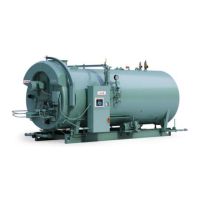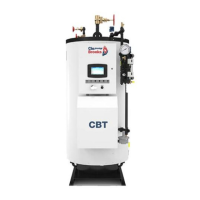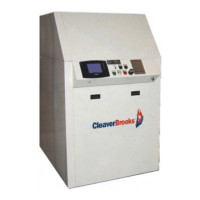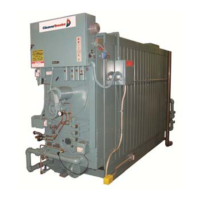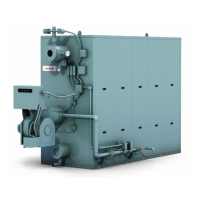750-392
CBEX-DE
2-9
Blowdown - Steam Boilers
2.7 — Blowdown - Steam Boilers
Boiler water blowdown is the removal of some of the concentrated water from the pressure vessel and its replace-
ment with feedwater so that the lowering of concentration of dissolved solids in the boiler water occurs.
Dissolved solids are brought in by the feedwater even though the water may be treated prior to use through exter-
nal processes that are designed to remove unwanted substances which contribute to scale and deposit forma-
tions. However, none of the processes can remove all substances. Regardless of their efficiency, some dissolved
solids will be present in the boiler feedwater.
Dissolved solids become less soluble in the high temperature of the boiler water and tend to accumulate on heat-
ing surfaces. Therefore blowdown and internal chemical treatment are required to prevent the solids from form-
ing harmful scale and sludge.
Scale has a low heat transfer value and acts as an insulation barrier. Scale retards heat transfer, which not only
results in lower operating efficiency, and consequently higher fuel consumption, but equally important, can cause
overheating of boiler metal. Overheating of boiler metal can result in tube failures or other pressure vessel metal
damage and lead to boiler downtime and costly repairs.
Scale is caused primarily by calcium and magnesium salts, silica and oil. Any calcium and magnesium salts in
the boiler water are generally precipitated by the use of sodium phosphate, along with organic materials, to
maintain the precipitates or “sludge” in a fluid form. The solids such as sodium salts and suspended dirt do not
readily form scale. But as the boiler water boils off as relatively pure steam, the remaining water is thickened
with the solids. If the concentration is permitted to accumulate, the sludge will build possibly causing overheat-
ing of the metal.
Therefore, it is necessary to control the amounts of totally dissolved solids (TDS) and sludge in the following
ways.
2.7.1 — Types of Blowdown
The two principal types of blowdown are intermittent manual blowdown and continuous blowdown.
Intermittent Manual Bottom Blowdown
Manual or sludge blowdown is necessary for the operation of the boiler whether or not continuous blowdown is
employed.
The blowdown tappings are located at the bottom or lowest part of the boiler in order to rid the sludge in the
lower part of the vessel.
! Warning
Be sure to drain the hot water to a safe point of discharge to avoid scalding. Failure to follow these
instructions could result in serious personal injury or death
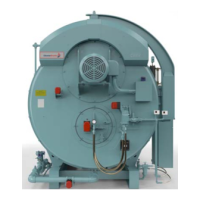
